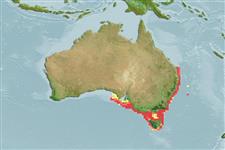>
Eupercaria/misc (Various families in series Eupercaria) >
Sillaginidae (Smelt-whitings)
Etymology: Sillago: From a locality in Australia.
Eponymy: Matthew Flinders (1774–1814) was an English explorer and navigator who joined the British Navy and trained as a navigator, having wanted to be a sailor and explorer ever since reading Robinson Crusoe. [...] (Ref. 128868), visit book page.
Environment: milieu / climate zone / distribuzione batimetrica / distribution range
Ecologia
marino demersale; oceanodromo (Ref. 51243); distribuzione batimetrica 1 - 180 m (Ref. 6205), usually ? - 80 m (Ref. 27575). Temperate; 25°S - 44°S, 132°E - 154°E
Western Pacific: southern Queensland to Anxious Bay, South Australia, and the east coast of Tasmania.
Length at first maturity / Size / Peso / Age
Maturità: Lm 14.5, range 14 - 16 cm
Max length : 32.0 cm TL maschio/sesso non determinato; (Ref. 6335); Età massima riportata: 7 anni (Ref. 27578)
Spine dorsali (totale) : 12; Raggi dorsali molli (totale) : 16 - 18; Spine anali: 2; Raggi anali molli: 18 - 20; Vertebre: 32 - 34. Coloration is very similar to S. bassensis. No dark spot at the base of the pectoral fin; a series of oblique rusty brown bars on back and upper sides, with a longitudinal row of rusty brown blotches along the midlateral silver stripe.
Body shape (shape guide): fusiform / normal; Cross section: circular.
Live close to the sea bed over sandy substrates. They normally inhabit depths from the surf zone to 80 m (Ref. 27575), although small catches have been taken from deeper water (Ref. 6335). Juveniles congregate in shallow water where they may be taken by line in large quantities. Feed mainly on crustaceans, amphipods, decapods, mysids and copepods. Juveniles consume mostly copepods (Ref. 6223). Oviparous (Ref. 205). Spawn from October to March in southern New South Wales but spawn in winter in southeast Queensland and northern New South Wales (Ref. 6205).
It is likely that this species spawn more than once during the spawning period, and that some eggs are resorbed by females at the end of the spawning season (Ref. 27577).
McKay, R.J., 1992. FAO Species Catalogue. Vol. 14. Sillaginid fishes of the world (family Sillaginidae). An annotated and illustrated catalogue of the sillago, smelt or Indo-Pacific whiting species known to date. Rome: FAO. FAO Fish. Synop. 125(14):87p. (Ref. 6205)
IUCN Red List Status (Ref. 130435: Version 2025-1)
Threat to humans
Harmless
Human uses
Pesca: elevato interesse commerciale
Strumenti
Special reports
Download XML
Fonti Internet
Estimates based on models
Preferred temperature (Fonte Biblio.
123201): 14.1 - 20.1, mean 15.4 °C (based on 166 cells).
Phylogenetic diversity index (Fonte Biblio.
82804): PD
50 = 0.5000 [Uniqueness, from 0.5 = low to 2.0 = high].
Bayesian length-weight: a=0.00832 (0.00351 - 0.01970), b=3.07 (2.86 - 3.28), in cm total length, based on LWR estimates for this (Sub)family-body shape (Ref.
93245).
Trophic level (Fonte Biblio.
69278): 3.3 ±0.43 se; based on food items.
Generation time: 2.4 ( na - na) years. Estimated as median ln(3)/K based on 1
growth studies.
Resilienza (Fonte Biblio.
120179): Medio, tempo minimo di raddoppiamento della popolazione 1.4 - 4.4 anni (K=0.46(?); tm=2; tmax=7; Fec=30,000).
Fishing Vulnerability (Ref.
59153): Low vulnerability (22 of 100).
🛈
